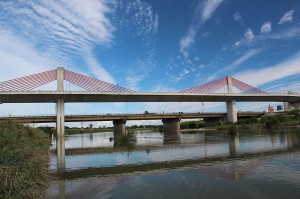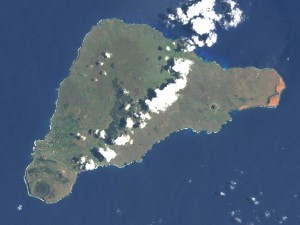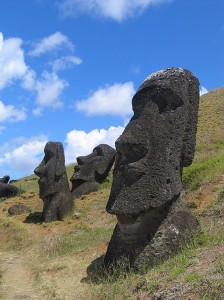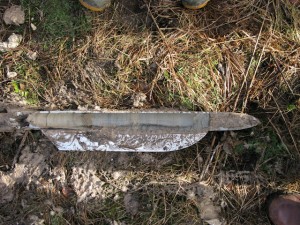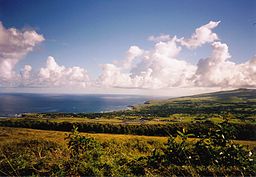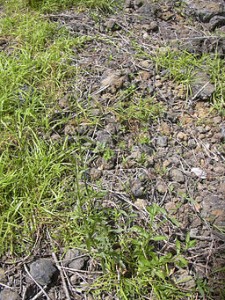Among other sessions on Tuesday (Day 2 at EGU2014), I (Daniel) ventured to the EGU Press Conference featuring four experts from different scientific disciplines debating the Anthropocene concept. This term is fast becoming well-known in the popular media, politics and a vast spectrum of scientific disciplines and refers to the possibility that we, humanity, are living in a new geological time period in which our activities are the driving force behind present-day landscape evolution and surpass natural processes. As my own research spans geomorphology, Quaternary environmental and climatic change and past landscape evolution in general, I’m keen to keep abreast of the latest developments pertaining to the Anthropocene so it seemed like an opportune session to attend.
First up was Professor John Burrows, an atmospheric chemist who briefly presented data obtained from satellites of atmospheric emissions driven by human activity, particularly around urbanised regions, and likely future trends. Tony Brown, a Professor of Physical Geography at Southampton, and the chair of the British Society of Geomorphology Working Group on the Anthropocene then spent some time outlining the stratigraphic signature of the Anthropocene we can seek within alluvial sediments. Brown re-emphasised that a depositional feature or an erosional hiatus that is laterally extensive is required for any Anthropocene ‘boundary’ to be considered. His case study of the River Severn basin and its sub-basins showed a tremendous increase in sediment load after around 3000 years ago, directly driven by the introduction of agricultural practices in late-Neolithic and early-Bronze Age times. The removal of forest cover left a hilly landscape highly susceptible to erosion and a dramatic spike in sediment flux is thus recorded. Such a signal is found in different sedimentary environments in many areas of the world, including river systems and lake sediment cores, and is well-supported by archaeological data. The difficulty arises from the time-transgressive nature of such deposits because the agricultural revolution arrived in different regions of the world at very different periods. One interesting point Brown made relates to the need for any signature to persist through time preserved within the rock record. His calculated sediment load stored within floodplains is so large that, based on contemporary erosion rates, will not be removed until at least the next interglacial, thereby meeting that specific criteria. We also heard from Dr Pöppl, a geomorphologist from the University of Vienna, who showed some striking examples of the magnitude of impacts on sedimentary systems through the installation and removal of large dams.
Finally, Dr Jan Zalasiewicz, a palaeobiologist from the University of Leicester who has published some seminal papers on the Anthropocene concept, outlined the on-going work of the ‘Anthropocene Working Group’ of the International Commission on Stratigraphy examining whether it merits becoming a formal geological unit of time. One important revelation from Dr Zalasiewicz was that, while decisions taken by the ICS are lengthy processes, an interim report may appear sometime in 2016 addressing whether the Anthropocene is worthy of being designated as its own geological unit and, secondly, the date to be assigned as its onset. Dr Zalasiewicz also stated that, at present, the commission are leaning towards adapting 1950 as the ‘golden spike’, the so-called Great Acceleration as coined by Steffen et al. (2007), although he emphasised this is very much still under debate. He also highlighted that the Anthropocene Commission is unique at the ICS in that non-geologists and noted sceptics of the idea are sitting on the panel to ensure that the decision taken considers all view-points and stands up to scrutiny.
There was limited time at the end of questions from the press but one that sticks me is the relevance of the concept and whether it really matters that the Anthropocene is ratified by the ICS (or not). Burrows made the valid point that it’s imperative, in fact, that the Anthropocene be formalised as a geological entity to drive political action towards adapting a more sustainable future for the planet. That is certainly a view I share!
A couple of final points I’d like to highlight is that EGU is running a live-stream of all press conferences this week – check them out here – and the Anthropocene session taking place on Thursday: Orals in room G10, posters in Blue Room 243-279 (GM4.1/HS9.12/SSS9.18
Human-Earth interaction from the Pleistocene to the Anthropocene: state of the science and future direction).
Steffen, W., Crutzen, P. and McNeill, J. (2007) The Anthropocene: Are humans now overwhelming the great forces of nature? AMBIO 36 (8), 614-621.

